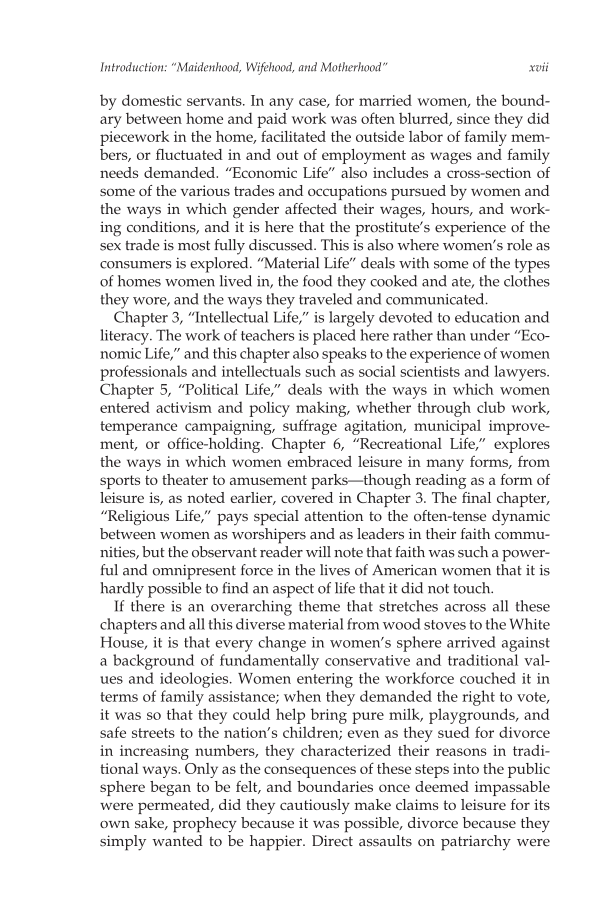Introduction: “Maidenhood, Wifehood, and Motherhood” xvii by domestic servants. In any case, for married women, the bound- ary between home and paid work was often blurred, since they did piecework in the home, facilitated the outside labor of family mem- bers, or fluctuated in and out of employment as wages and family needs demanded. “Economic Life” also includes a cross-section of some of the various trades and occupations pursued by women and the ways in which gender affected their wages, hours, and work- ing conditions, and it is here that the prostitute’s experience of the sex trade is most fully discussed. This is also where women’s role as consumers is explored. “Material Life” deals with some of the types of homes women lived in, the food they cooked and ate, the clothes they wore, and the ways they traveled and communicated. Chapter 3, “Intellectual Life,” is largely devoted to education and literacy. The work of teachers is placed here rather than under “Eco- nomic Life,” and this chapter also speaks to the experience of women professionals and intellectuals such as social scientists and lawyers. Chapter 5, “Political Life,” deals with the ways in which women entered activism and policy making, whether through club work, temperance campaigning, suffrage agitation, municipal improve- ment, or office-holding. Chapter 6, “Recreational Life,” explores the ways in which women embraced leisure in many forms, from sports to theater to amusement parks—though reading as a form of leisure is, as noted earlier, covered in Chapter 3. The final chapter, “Religious Life,” pays special attention to the often-tense dynamic between women as worshipers and as leaders in their faith commu- nities, but the observant reader will note that faith was such a power- ful and omnipresent force in the lives of American women that it is hardly possible to find an aspect of life that it did not touch. If there is an overarching theme that stretches across all these chapters and all this diverse material from wood stoves to the White House, it is that every change in women’s sphere arrived against a background of fundamentally conservative and traditional val- ues and ideologies. Women entering the workforce couched it in terms of family assistance when they demanded the right to vote, it was so that they could help bring pure milk, playgrounds, and safe streets to the nation’s children even as they sued for divorce in increasing numbers, they characterized their reasons in tradi- tional ways. Only as the consequences of these steps into the public sphere began to be felt, and boundaries once deemed impassable were permeated, did they cautiously make claims to leisure for its own sake, prophecy because it was possible, divorce because they simply wanted to be happier. Direct assaults on patriarchy were
Document Details My Account Print multiple pages
Print
You have printed 0 times in the last 24 hours.
Your print count will reset on at .
You may print 0 more time(s) before then.
You may print a maximum of 0 pages at a time.
























































































































































































































































































































































































































































































